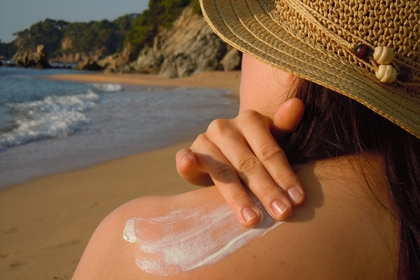|
DIVULGAÇÃO
FDA study confirms sunscreen chemicals are absorbed through skin. New research from the US Food and Drug Administration (FDA), following up on a pilot study published last year, has confirmed six active ingredients found in sunscreen products can be detected in the blood of users after just one application. Experts not affiliated with the new research urge people to continue using sunscreen as there is no evidence to suggest these findings point to negative health consequences. Last year, the FDA published the results of a small pilot study finding regular application of several common sunscreen formulations resulted in detectable blood concentrations of four key sunscreen chemicals: avobenzone, oxybenzone, octocrylene, and ecamsule. At the time the preliminary study was criticized for its small sample size, as well as the excessive application levels tested. This follow-up study expanded its sample size, tested a broad assortment of active ingredients, and investigated blood absorption following just one single application of sunscreen.  A new toxicology study confirms sunscreen chemicals can be absorbed through the skin into the bloodstream, but no hazardous health effects have been suggested. katia26/Depositphotos
The threshold of 0.5 ng/mL noted in the study is not one established as inherently unsafe, however, the FDA researchers do suggest this particular threshold, “was selected because the approximated cancer risk associated with plasma concentrations below this threshold would be less than 1 in 100,000 after a single dose.” While these results certainly seem concerning, experts are urging the public to continue using sunscreen where necessary, as the cancerous consequences of UV exposure are well established. Whereas this new study does not investigate, or even hypothesize, any potential health effects from the observed blood absorption levels. Rob Chilcott, a toxicologist from the University of Hertfordshire, says the study’s findings are somewhat expected as it is known the skin is not a solid barrier, and can absorb chemicals from superficial applications. “This does not mean that sunscreen products are unsafe to use, but that appropriate safety tests need to be performed by manufacturers,” says Chilcott, who did not work on this FDA study. “It should be emphasized that the health benefits of using sunscreens are well established and far outweigh the risks of not protecting the skin from excessive sun exposure.” Antony Young, from King’s College London, echoes these sentiments, affirming there is no clear evidence of negative mortality effects from sunscreen usage but there is clear evidence UV exposure is dangerous. “Overall, there is increasing evidence that sunscreens applied to the skin can enter into the circulation,” says Young, who also did not work on this new study. “The problem is that we do not know what the health effects of this are. From limited data there is no evidence that long term sunscreen use has any effect on mortality. If used correctly, sunscreens are an excellent way to prevent the short and long term adverse effects of solar UVR. There is no reason for this to change.” Published in tandem with the new study is an accompanying editorial co-authored by Kanade Shinkai, the editor-in-chief of the journal JAMA Dermatology. The editorial has the subtitle “Balancing Benefits with Unknown Harms”, and primarily addresses the risk-benefit considerations clinicians should use to evaluate how widely they recommend sunscreen use to patients. “… should clinicians continue to recommend the use of chemical sunscreen?” ask Shinkai and co-author Adewole Adamson. “This is a pragmatic question that affects the daily regimen of many individuals and is a critical clinical question. In making an informed decision, clinicians must determine whether the magnitude of the benefit exceeds the risk of potential harm for a specific individual. Importantly, this balance may be different, depending on characteristics of the sunscreen user (eg, for individuals with darker skin types and for children) and may depend on the frequency and duration of application (eg, daily vs intermittent use; starting in infancy or later in life).” Ultimately, it is still unclear what harms, if any, there are from the plasma absorption of these sunscreen chemicals. Safety studies are yet to be completed, and Shinkai and Adamson suggest chemical sunscreens still should form part of a broader UV safety plan that also includes wearing protective clothing and simple avoidance of intense sun exposure. The new research was published in the journal JAMA. By Rich Haridy. New Atlas. Posted: Jan 21, 2020. Testando nanopartículas em protetores solares. Nova geração de cremes solares contendo fragmentos de DNA.
|
||||||||||||||||||||||||